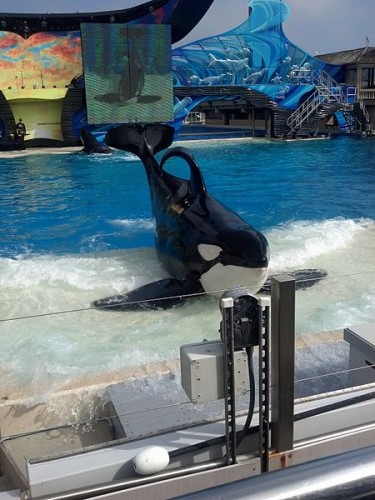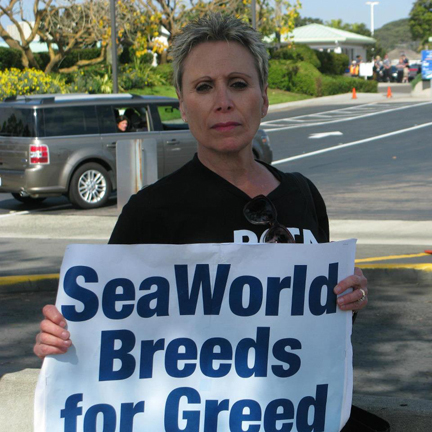“Lots of people talk to animals. Not very many listen, though. That’s the problem.”
–Benjamin Hoff, The Tao of Pooh
This is the third in a series of ten in which we meet one of the San Diego 10 orcas and hear from an advocate who continues to be one of the voices of these imprisoned voiceless, never stopping until the whole world listens.
Prisoner #3: Ulises
Age: About 36

Ulises, the oldest male orca in captivity, and the second largest (the largest being Tilikum, 12k pounds) is also a good candidate for a full return to the ocean. This hefty, Icelandic orca is 19 feet 6 inches (5.94 m), weighing 9,200 pounds (4,200 kg). Easily discernible, one can recognize him as not only being the largest captive whale imprisoned in Sea World San Diego, but he has the tallest dorsal; it stands straight up and droops ever so slightly to the right at the top.
A true “hunk,” Ulises has large pectoral muscles, his tail is curved, and his left eye is blue, while his right one is brown. There are also a few black dots on his chin, along with a bump caused by an injury. His nicknames are Uli, Big Dog and Uli Bear.
In spite of his massive size, he’s known to have the gentlest of natures, called a “sweetheart” by those who know him. That’s quite amazing because this gentle giant spent his first 13 years of captivity alone—without any other orcas in his world.
Though he had a thing for Orkid, it seems to be unrequited, even though they spend a lot of time together vocalizing and playing. He is ranked very low in the imprisoned orca world so that might attribute to his submissive nature, and the fact that he’s perpetually “raked” by Kasatka and the other whales. Most of the time he spends swimming upside-down , similar to Corky.
Ulises was captured on November 07, 1980 at Reydarfjördur, Iceland, when he was approximately 3 years old. Only Ulises and another orca, Bjossa, survived that capture. Later, he was transferred to several parks including the Sædyrasafnid Aquarium in Iceland (November/December 1980), the Rioleón Safari (December 1980 to June 1983), and Barcelona Zoo (June 1983 to January 1994) in Catalonia, where he spent the next few years imprisoned with bottlenose dolphins who bullied him continually. Outgrowing the tank there, deeply depressed and alone for so many years, he was eventually transported to SeaWorld in 1994 for breeding purposes, where he lives at present.
At Sea World San Diego, Ulises bred a few female orcas , but had a low sperm count and wasn’t able to impregnate them. Eventually in 2011, Ulises became a father when his son was born through artificial insemination to Wikie at Marineland Antibes, France. The calf was first thought to be a female and therefore named Moana (which means “ocean” in Polynesian). It was later discovered that “Moana” was a male.
Ulises used to do waterworks with his trainers at Sea World until it was stopped in 2010, but resumed off and on through the years. He gets mostly along with his fellow orcas but will try to rake an older female, Corky II whenever he can. He was also dominant over Splash when that orca was still at the park.
Kalia has often shown aggression towards him and they are not always grouped together because of this and yet…and yet. Compatibility is not an issue within this abusement park. It’s all about breeding—and it doesn’t matter how young . In the wild, orcas rarely mate until they are around the age of 14 or 15. Yet in captivity, they are artificially inseminated when just half that age.
An example of this inequity is that of Kalia, the nine-year-old daughter of Kasatka. Nine years old! Still a child herself and yet it was recently revealed that she is pregnant, with Ulises being the artificially inseminated father of her baby due in December of this year. Here’s a male orca, Ulises, who has been unable to impregnate several times, but whose semen is being used for breeding—another profit center for SeaWorld Entertainment, Inc. Yet more motive for Sea World to not want to phase out performing orcas, since there would be no demand for its semen.
Another example of SeaWorld Entertainment, Inc.’s captive breeding profit center is the saga of Morgan, a young female Norwegian orca rescued off the coast of the Netherlands in a severely weakened state in 2010. As both a female and a wild orca with DNA that is new to the captive orca gene pool, Morgan is an extremely valuable animal.
Although the permit to rescue her was predicated on her rehabilitation and return to the wild, SeaWorld Entertainment Inc. petitioned in 2011 to move her to Loro Parque in the Canary Islands (in the central Atlantic, a territory of Spain), where it has several orcas on loan.
In an email, Loro Parque spokesperson Patricia Delponti says that Loro Parque is simply Morgan’s “holding facility” and that Loro Parque does not own Morgan. In contrast, in filings with the U.S. Securities and Exchange Commission related to its IPO last year, SeaWorld Entertainment, Inc. has made it clear that it considers Morgan to be part of its killer whale collection, as one of the group of whales it has on loan to Loro Parque. Just this week, the Dutch Council of State ruled that Morgan’s highly-contested 2011 move to an amusement park in Spain was lawful, and that — for now at least — Morgan will not be returned to the ocean.
And as far as Ulises is concerned, he needs to be rewarded with a freedom that was taken away from him as a child and is far more than a baby-making machine. There’s still hope for a compassionate retirement for him and all the other captives.
Prisoner Advocate: Ellen R. Ericksen

When did her activism first start? Ellen recalls it clearly:
“I was born and raised in NYC. My very first encounter with the animals and the cruelty and suffering inflicted on them was at the age of 3-4 years old. My mother took me to Madison Square Garden to the Ringling Bros. Circus. I remember a good portion of that day even now, because I was so traumatized by what I witnessed there. After the show we went backstage to see the elephants. I was so close to them.
They were all lined up against a wall. They were behind just a rope. I was so appalled even at such a young age and so upset witnessing how distressed they were. I remember screaming and crying because they looked so sad and unhappy. I actually felt their pain even at that young age; and I remember being dragged out by my mother because it was so hard for me to see and feel.”
That was Ellen’s first “direct action” as an activist. Later, in her teens, she recalled:
“I became involved with injustices at my high school, in how the girls had to dress. I staged and organized a sit-in despite being threatened by suspension. The media came. The sit-in worked and the dress code was modified.”
After high school Ellen spoke in college about the environment and the war and was very active in both those movements. Jump ahead several years and the AIDS crisis started happening. By that time Ellen was living in Palm Springs and her son was very young. It was during that time that she brought awareness to many; she worked at an AIDS/HIV clinic and did counseling and collected blood for the anonymous testing center. She raised money and helped organize many charitable events. She found it all very fulfilling.
After she went through a transformative time in her life, she moved to San Diego and connected to her love for activism. Since then, Ellen has organized a tremendous amount of events and protests in Southern California for several years now. In fact, she has dedicated her entire life to fighting against animal abuse.
In spite of managing a full-time dental practice, Ellen knows how to prioritize her passion for animals and veganism. Her home is filled to the rafters with boxes of leaflets and signs and brochures. There’s a cardboard cow and an orca in the middle of one room and more boxes of print material.
Her very patient husband supports her dedicated focus which makes life even easier.
“There is a thrill in organizing groups of people—young and old—to stand up for something they believe in strongly. I especially love it when young people join in my safe protests. It’s very effective when children come to different venues like Sea World with their families and witness kids protesting.”
Some of her protests are small in number; some even involve just herself speaking out; and some that she’s organized involve whole city blocks of marchers like the recent one in Los Angeles.
“It’s so empowering being with others working together. I’ll never forget the joy I felt turning around and seeing over 300 Elephant Walk marchers behind me, all wearing red tops and holding signs fighting the elephant ivory trade. That was a wonderful march.”
A devout vegan and greatly involved in vegan outreach campaigns, Ellen is also expanding her horizons and has started speaking at universities and schools here in San Diego, educating people about compassion and the movie Blackfish as well as the importance of veganism. She says that:
“I’ve been protesting Sea World for several years, every single holiday year-round even before Blackfish. We’re not going away until Sea World changes it up.
“I’m just outraged at what is a form of animal abuse there. These animals—and I mean not only orcas, but penguins, dolphins, sea lions—none of them have a choice.
It’s truly slavery in the name of entertainment. It’s vile. But the orcas’ enormous size, trapped inside those cage-like swimming pools with no freedom—it’s unnatural. What they’re restricted to tugs at my heart. It makes me sick to my stomach.
Do you realize that Corky has been in captivity there for 44 years?!!!! I can’t even imagine that. It breaks my heart. Breaks my soul. It’s all about money and greed. The orcas are not performers. They’re not entertainers. They deserve the same respect and dignity to live as we do.”
But there is hope.
Ellen believes that the protests could end and:
“…SeaWorld could turn this around by becoming a compassionate company at last. People would pay to see the whales in their natural habitat. There could be exciting rides and Imax and lots of interactive, multi-media features that would definitely attract and keep crowds coming there, without the need to see such beautiful, intelligent, sensitive animals forced to perform and kept in horrendous lifestyles so foreign to them in every way. I just want this to end. It has to stop. It’s time for Sea World to change for the better.”
Her greatest wish?
“To liberate all animals and not have them held captive ever. To make people aware of animal cruelty in all forms—from entertainment to clothing, cosmetics, food—anything that involves animal abuse. Until that day arrives, I won’t stop protesting.”
DEMAND a reconsideration in MORGAN’s verdict.
“Unless someone like you cares a whole awful lot, nothing is going to get better. It’s not.” – Dr. Seuss, The Lorax
